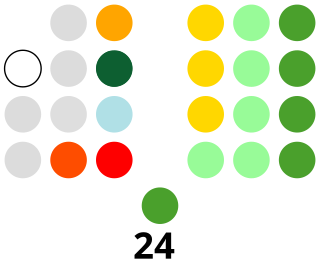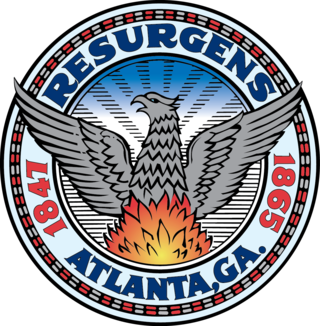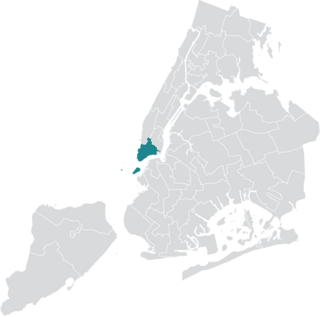Bicameralism is a type of legislature that is divided into two separate assemblies, chambers, or houses, known as a bicameral legislature. Bicameralism is distinguished from unicameralism, in which all members deliberate and vote as a single group. As of 2022, roughly 40% of world's national legislatures are bicameral, while unicameralism represents 60% nationally and much more at the subnational level.
Unicameralism is a type of legislature, which consists of one house or assembly, that legislates and votes as one. Unicameralism originated from France during the French Revolution through the French Constitution of 1791, then later spread throughout the world. Unicameralism has become an increasingly common type of legislature, making up nearly 60% of all national legislatures and an even greater share of subnational legislatures.

The Congress of the Philippines is the legislature of the national government of the Philippines. It is bicameral, composed of a lower body, the House of Representatives, although colloquially the term "Congress" commonly refers to just the latter, and an upper body, the Senate. The House of Representatives meets in the Batasang Pambansa in Quezon City while the Senate meets in the GSIS Building in Pasay.
An alderman is a member of a municipal assembly or council in many jurisdictions founded upon English law. The term may be titular, denoting a high-ranking member of a borough or county council, a council member chosen by the elected members themselves rather than by popular vote, or a council member elected by voters.

The Philadelphia City Council, the legislative body of Philadelphia, Pennsylvania, consists of ten members elected by district and seven members elected at-large. The council president is elected by the members from among their number. Each member's term is four years, and there are no limits on the number of terms a member may serve.
An upper house is one of two chambers of a bicameral legislature, the other chamber being the lower house. The house formally designated as the upper house is usually smaller and often has more restricted power than the lower house. A legislature composed of only one house is described as unicameral.

Honolulu City Council is the legislature of the City and County of Honolulu, the capital and largest city in Hawai'i, the fiftieth state in the United States. The City and County of Honolulu is a municipal corporation that manages government aspects traditionally exercised by both municipalities and counties in other states. Each of the nine members of its city council is elected to a four-year term and can serve no more than two consecutive terms. Council members are elected by voters in nine administrative districts that, since 1991, are reapportioned every ten years. Like the Honolulu mayor, members of the city council are elected via nonpartisan elections.

The Seattle City Council is the legislative body of the city of Seattle, Washington. The Council consists of nine members serving four-year terms, seven of which are elected by electoral districts and two of which are elected in citywide at-large positions; all elections are non-partisan. It has the sole responsibility of approving the city's budget, and develops laws and policies intended to promote the health and safety of Seattle's residents. The Council passes all legislation related to the city's police, firefighting, parks, libraries, and electricity, water supply, solid waste, and drainage utilities. (The mayor of Seattle is not considered part of council.)

The New York City Council is the lawmaking body of New York City in the United States. It has 51 members from 51 council districts throughout the five boroughs.
The borough president is an elected office in each of the five Boroughs of New York City. For most of the city's history, the office exercised significant executive powers within each borough, and the five borough presidents also sat on the New York City Board of Estimate. Since 1990, the borough presidents have been stripped of a majority of their powers in the government of New York City.
A municipal council is the legislative body of a municipality or local government area. Depending on the location and classification of the municipality it may be known as a city council, town council, town board, community council, rural council, village council, or board of aldermen.

The Legislature of the Hawaiian Kingdom was the bicameral legislature of the Hawaiian Kingdom. A royal legislature was first provided by the 1840 Constitution and the 1852 Constitution was the first to use the term Legislature of the Hawaiian Islands, and the first to subject the monarch to certain democratic principles. Prior to this the monarchs ruled under a Council of Chiefs.

The Atlanta City Council is the main municipal legislative body for the city of Atlanta, Georgia, United States. It consists of 16 members: the council president, twelve members elected from districts within the city, and three members representing at-large posts. The city council is the legislative branch of the Atlanta city government.

New York City's 1st City Council district is one of 51 districts in the New York City Council. It is currently represented by Democrat Christopher Marte, who took office in 2022.

The City of Chicago has held elections to its City Council since its incorporation in 1837. Elections were held annually from 1837 through 1921, biennially from 1923 through 1933, and quadrennially starting in 1935. From 1851 through 1922 the Council was staggered and half of it was chosen at each election, but before 1851 and since 1923 the entire Council has been elected at each election.

An election was held in New York City to election the President of its Council on November 2, 1897. The charter of the new City of Greater New York had created a bicameral Municipal Assembly, comprising an upper Council and a lower Board of Aldermen. The Council president was elected citywide while the Board of Aldermen elected its own president.

An election was held to fill the Municipal Assembly of the newly-created City of Greater New York on November 2, 1897. The charter of the new city had created a bicameral Municipal Assembly, consisting of an upper Council and a lower Board of Aldermen. Each chamber was elected from specially-made districts. In addition, the president of the Council was elected in a separate election on the same day.

The Boston City Charter is a series of State statutes which codifies a system of rules for the government of the City of Boston, Massachusetts. The Charter is not a typical city constitution but rather a series of amendments, General Court rulings, and case law which form the basis of government. The central organs of the Boston City Charter are the Mayoral Office and City Council. The composition of these offices, their term length, manner of election, and scope of power have changed throughout the years.

New York City was divided into wards between 1683 and 1938. These were used for the election of various municipal offices, and would later be used to construct the boundaries of larger electoral districts. Prior to the formation of the so-called City of Greater New York in 1898, what is now New York City comprised multiple municipalities that had different histories with wards.
From 1822 until 1909, Boston's legislative body was bicameral, with a Board of Aldermen that was elected at-large and a much larger Common Council with members that was elected from multi-member wards. This city legislature was replaced in 1909 with the unicameral body that is the modern Boston City Council.













